Use Southern Cultures in the classroom
Southern Cultures is a prime source for southern food scholarship. Three special issues devoted to food studies and regular contributions on foodways demonstrate the journal’s methodological strengths—oral history, ethnography, archival-based research. The following selections demonstrate the power of food to illuminate the nuances of social and cultural history in the South.
“Drum Head Stew: The Power and Poetry of Terroir”
Bernard L. Herman, Vol. 14, No. 4 (Winter 2009)
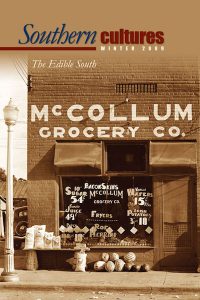 Herman’s essay is an excellent introduction to food studies. His interviews with and photographs of local residents in coastal communities of Northampton County, Virginia help illustrate “taste of place,” or the concept of “terroir.” Their talk of stews made of drum fish, heirloom potato cultivation and cyclical celebrations point to deep relationships with indigeneity, environmental complexities, perseverance, regional occupations, and the past. Herman writes: “Terroir is experience and emotion, embodiment and immediacy, custom and invention, destiny and storytelling. It manifests itself in a constantly evolving style and synthesis of ingredients, recipes, preparations, and eating, from fancy holiday meals to work day lunches” (38). Part of his ongoing work with foodways and cultural heritage, Herman’s essay demonstrates the nuanced insights that are made possible through ethnographic engagement. (For more, see Herman’s other food essays in Southern Cultures.)
Herman’s essay is an excellent introduction to food studies. His interviews with and photographs of local residents in coastal communities of Northampton County, Virginia help illustrate “taste of place,” or the concept of “terroir.” Their talk of stews made of drum fish, heirloom potato cultivation and cyclical celebrations point to deep relationships with indigeneity, environmental complexities, perseverance, regional occupations, and the past. Herman writes: “Terroir is experience and emotion, embodiment and immediacy, custom and invention, destiny and storytelling. It manifests itself in a constantly evolving style and synthesis of ingredients, recipes, preparations, and eating, from fancy holiday meals to work day lunches” (38). Part of his ongoing work with foodways and cultural heritage, Herman’s essay demonstrates the nuanced insights that are made possible through ethnographic engagement. (For more, see Herman’s other food essays in Southern Cultures.)
“Feeding the Jewish Soul in the Delta Diaspora”
Marcie Cohen Ferris, Vol. 10, No. 3 (Fall 2004)
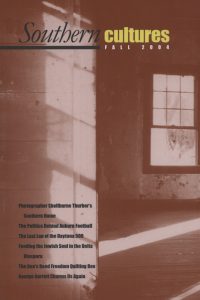 Looking closely at the historic experiences of individual Delta families, Cohen Ferris’s essay explores the culinary, spiritual, and social world of Jews in small-town Mississippi. She traces the history of the Delta’s Jewish community to their beginnings as rural peddlers in the late 19th century and through to their establishment of businesses and successful cotton farms. Jewish foodways emerge as significant expressions of identity and belonging for a group who often found themselves walking the socio-cultural line between white and black worlds. Everyday practices of Delta Jews, such as bringing back bagels, lox, corned beef and dark loaves of pumpernickel bread from Jackson, Memphis or Birmingham, are defining of “a unique expression of American Judaism” (58). Cohen Ferris’s essay demonstrates well how to write the social and cultural history of groups through the food they treasure. (For more, see Cohen Ferris’s other essays in Southern Cultures.)
Looking closely at the historic experiences of individual Delta families, Cohen Ferris’s essay explores the culinary, spiritual, and social world of Jews in small-town Mississippi. She traces the history of the Delta’s Jewish community to their beginnings as rural peddlers in the late 19th century and through to their establishment of businesses and successful cotton farms. Jewish foodways emerge as significant expressions of identity and belonging for a group who often found themselves walking the socio-cultural line between white and black worlds. Everyday practices of Delta Jews, such as bringing back bagels, lox, corned beef and dark loaves of pumpernickel bread from Jackson, Memphis or Birmingham, are defining of “a unique expression of American Judaism” (58). Cohen Ferris’s essay demonstrates well how to write the social and cultural history of groups through the food they treasure. (For more, see Cohen Ferris’s other essays in Southern Cultures.)
“‘A Recourse that Could be Depended Upon’: Picking Blackberries and Getting by after the Civil War”
Bruce E. Baker, Vol. 16, No. 4 (Winter 2010)
Baker uses Rhoda Halperin’s framework of “multiple livelihoods strategies” to examine how southerners made ends meet after the Civil War by harnessing natural resources in their regions (i.e., blackberries, fish, and nuts). The article draws attention to the importance of the commons and to informal economies, “invisible” things that continue to be important to communities across the South. This essay includes a close examination of the blackberry itself—what it is, where it grows, how to prepare it (including a couple of recipes)—and illustrates well how a thing like a blackberry (and food more generally) can be “good to think with.” Read an excerpt online, or access the full piece via Project Muse.
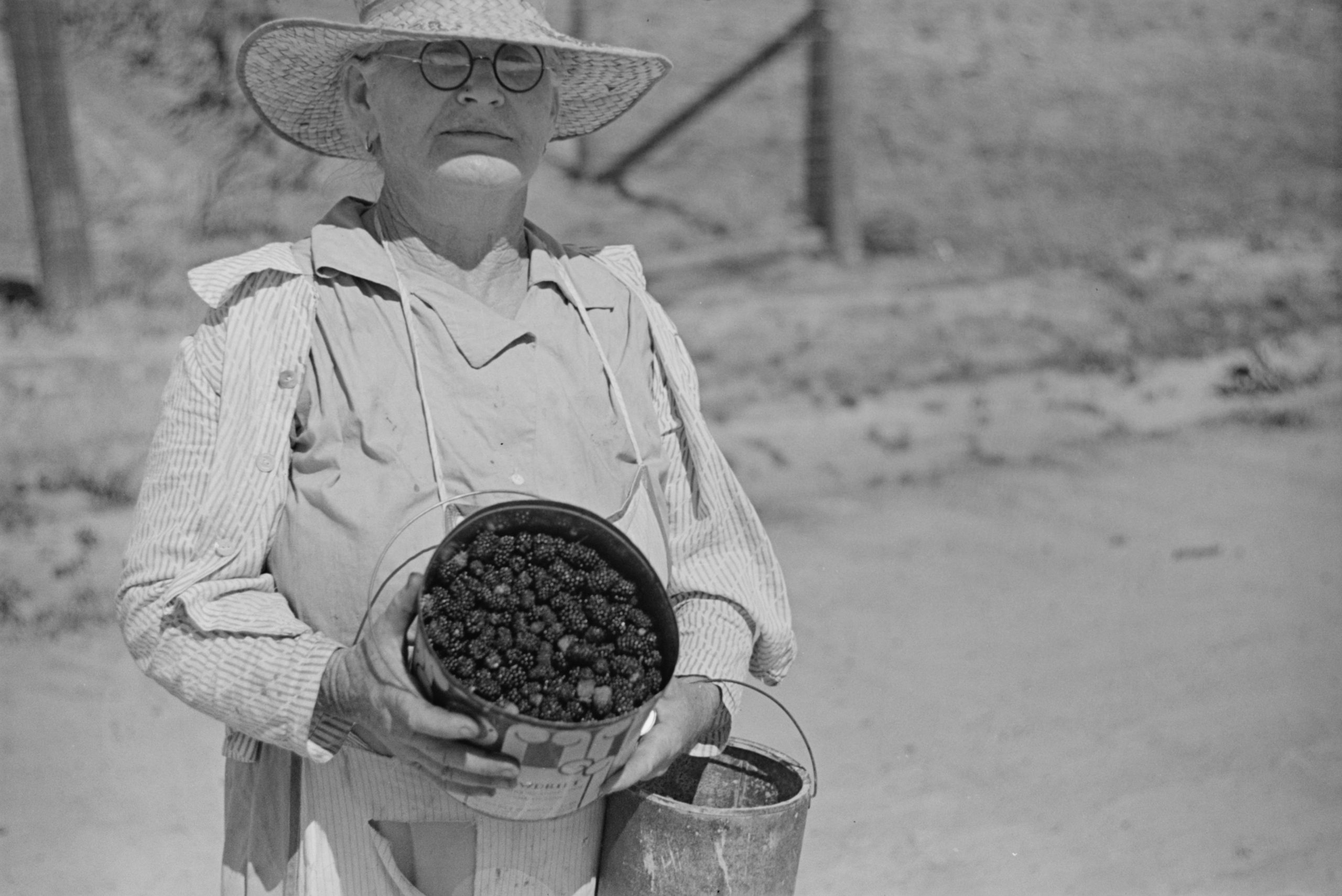 Grandmother MacDuffey, with blackberries picked from nearby swamps, Irwinville, Georgia, 1938, courtesy of the Collections of the Library of Congress.
Grandmother MacDuffey, with blackberries picked from nearby swamps, Irwinville, Georgia, 1938, courtesy of the Collections of the Library of Congress.
“Simply Necessity?: Aesthetics in Southern Home Canning”
Danille Elise Christensen, Vol. 21, No. 1 (Spring 2015)
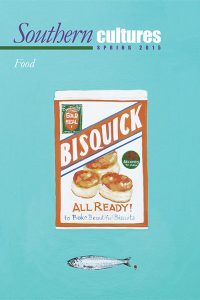 Writing against assumptions about the mere utilitarian nature of food preservation, Christensen gathers published testimony from southern women who describe home canning as pleasurable. Poor or well-off, rural or urban, women take pride in the aesthetic dimensions of canning, describing the variety and quantity of foods they process as well as the look of food within jars and on shelves. Christensen also draws attention to the ways in which the exchange of home grown and processed foods in communities reinforces social ties. Her essay provides an excellent example of how to attend to aesthetic and expressive dimensions of socio-cultural phenomena. (To demonstrate how food processing has been an important home industry for women, leading to social and material capital, pair this with Elizabeth S. D. Engelhardt’s “Canning Tomatoes, Growing ‘Better and More Perfect Women,'” Southern Cultures, Vol. 15, No. 4: The Edible South.)
Writing against assumptions about the mere utilitarian nature of food preservation, Christensen gathers published testimony from southern women who describe home canning as pleasurable. Poor or well-off, rural or urban, women take pride in the aesthetic dimensions of canning, describing the variety and quantity of foods they process as well as the look of food within jars and on shelves. Christensen also draws attention to the ways in which the exchange of home grown and processed foods in communities reinforces social ties. Her essay provides an excellent example of how to attend to aesthetic and expressive dimensions of socio-cultural phenomena. (To demonstrate how food processing has been an important home industry for women, leading to social and material capital, pair this with Elizabeth S. D. Engelhardt’s “Canning Tomatoes, Growing ‘Better and More Perfect Women,'” Southern Cultures, Vol. 15, No. 4: The Edible South.)
“Canning Tomatoes, Growing ‘Better and More Perfect Women’: The Girls’ Tomato Club Movement”
Elizabeth S. D. Engelhardt, Vol. 15, No. 4 (Winter 2009)
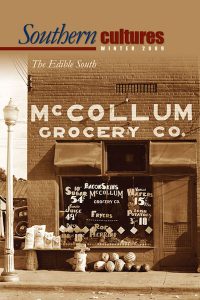 Englehardt reveals the story of how tomato clubs transformed girls’ lives across the South in the early twentieth century by providing them with the skills to cultivate, can and sell their own tomatoes. Englehardt uses the papers of one of the pioneers of the tomato club movement, former North Carolina teacher and women’s club member, Jane S. McKimmon, as well as historic photographs and historic newspaper coverage to reconstruct the atmosphere of the burgeoning home demonstration movement in the early 20th century. Englehardt includes details only available from archived primary sources to show just how productive the club activity was: “In this first year, McKimmons’s 440 girls produced 10,000 cans and realized an average profit per girl of $14.75 (in today’s money = $330)” (82). This essay provides a good model of how to do social history by looking for particular manifestations of individual and small-group engagement in larger social movements (in this case agricultural extension and home demonstration). Larger issues: food industry; women; agriculture; home economics; home demonstration. Read the complete piece online for free.
Englehardt reveals the story of how tomato clubs transformed girls’ lives across the South in the early twentieth century by providing them with the skills to cultivate, can and sell their own tomatoes. Englehardt uses the papers of one of the pioneers of the tomato club movement, former North Carolina teacher and women’s club member, Jane S. McKimmon, as well as historic photographs and historic newspaper coverage to reconstruct the atmosphere of the burgeoning home demonstration movement in the early 20th century. Englehardt includes details only available from archived primary sources to show just how productive the club activity was: “In this first year, McKimmons’s 440 girls produced 10,000 cans and realized an average profit per girl of $14.75 (in today’s money = $330)” (82). This essay provides a good model of how to do social history by looking for particular manifestations of individual and small-group engagement in larger social movements (in this case agricultural extension and home demonstration). Larger issues: food industry; women; agriculture; home economics; home demonstration. Read the complete piece online for free.
“Mother Corn and Dixie Pig: Native Foods in the Native South”
Rayna Green, Vol. 14, No. 4 (Winter 2008)
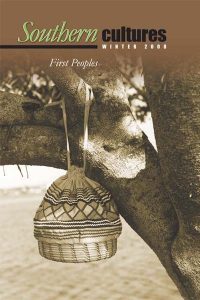 The southern culinary staples of “greens and grits” come from American Indian food culture, though almost no credit is given native people for their contributions to southern foodways. Green’s essay offers a corrective to this omission, tracing the historic significance of southeast Indian agricultural and culinary practices in the region. Beginning with the Indian Removals of the 1830s, which resulted in the cessions of prime Indian farmland, Green analyzes the ongoing phenomenon of Indian marginalization in the Southeast. She advocates for the reintroduction of Indian food to menus and farmer’s markets where “chefs that care so deeply about the restoration of southern food might want to join forces with the oldest farmers” (124). This essay is informative and provides a fine example of how history (and food history in particular) can function as advocacy. (For more, explore the entire Southern Cultures First Peoples issue.)
The southern culinary staples of “greens and grits” come from American Indian food culture, though almost no credit is given native people for their contributions to southern foodways. Green’s essay offers a corrective to this omission, tracing the historic significance of southeast Indian agricultural and culinary practices in the region. Beginning with the Indian Removals of the 1830s, which resulted in the cessions of prime Indian farmland, Green analyzes the ongoing phenomenon of Indian marginalization in the Southeast. She advocates for the reintroduction of Indian food to menus and farmer’s markets where “chefs that care so deeply about the restoration of southern food might want to join forces with the oldest farmers” (124). This essay is informative and provides a fine example of how history (and food history in particular) can function as advocacy. (For more, explore the entire Southern Cultures First Peoples issue.)
“The Case of Wild Onions:
The Impact of Ramps on Cherokee Rights”
Courtney Lewis, Vo. 18, No. 2 (Summer 2012)
“Finally, the defendant was called to testify. The air went from lighthearted post-lunch chatting to dour and intense. Judging from the sudden solemnity, one might have imagined that this trial was for drug trafficking or a violent crime. But it was about something that had much more profound implications: picking plants—specifically, wild onions.”
This essay provides a way to open a conversation about the relationship between land and food. Lewis introduces readers to the ecology of the ramp, a wild onion central in the springtime Cherokee diet, land rights and the idea of the commons. Lewis writes: “What started out that Monday as a seemingly minor case about picking onions unfolded into an astonishing story of land disappearances, mismarked boundaries and the legitimacy of indigenous scientific knowledge” (116). Lewis’s essay also addresses the land conservation movement, which may seem like a positive no-brainer to those living in mainstream, suburban culture, but which can actually be quite controversial in rural communities.
“Molasses-Colored Glasses: WPA and Sundry Sources on Molasses and Southern Foodways”
Frederick Douglass Opie, Vol. 14, No. 1 (Spring 2008)
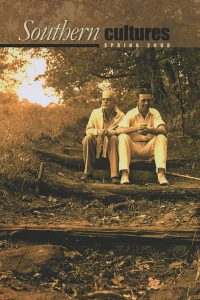 In his essay on this southern staple, Opie defines molasses, describes how it is made and by whom and how it was used in southern cooking. He examines its nutritional value (rich in vitamins and minerals) and the contexts in which it was eaten, establishing it as a working-class staple of African American, Indian and white southerners. Making use of WPA photographs, historic interviews and recollections of his own, Opie focuses most substantially on the development of molasses as an integral part of the African American diet. He includes multiple first-hand descriptions of common meals that included molasses: “Louis Armstrong recalled living for six months on a ‘supper of black molasses and a big hunk of bread’ at the Colored Waifs Home for Boys in New Orleans” (89). In the vein of Sidney Mintz’s classic sugar study, this essay provides a model of how to write food history.
In his essay on this southern staple, Opie defines molasses, describes how it is made and by whom and how it was used in southern cooking. He examines its nutritional value (rich in vitamins and minerals) and the contexts in which it was eaten, establishing it as a working-class staple of African American, Indian and white southerners. Making use of WPA photographs, historic interviews and recollections of his own, Opie focuses most substantially on the development of molasses as an integral part of the African American diet. He includes multiple first-hand descriptions of common meals that included molasses: “Louis Armstrong recalled living for six months on a ‘supper of black molasses and a big hunk of bread’ at the Colored Waifs Home for Boys in New Orleans” (89). In the vein of Sidney Mintz’s classic sugar study, this essay provides a model of how to write food history.
“She Ought to Have Taken Those Cakes:
Southern Women Regional Food Networks and Food Supplies”
Rebecca Sharpless, Vol. 18, No. 2 (Summer 2012)
Sharpless examines the social and economic significance of rural-urban food networks in the early twentieth century. Southern farm women—landowning, mostly white—with surplus vegetables and animal products (chickens, eggs, milk) could sell them in urban curb markets, to grocery chains, and, most significantly, to middle class town women. Sharpless’s essay points to the ways local sourcing developed a cache in this era, citing period recipes calling for “sweet country butter” and the grocery-store chain Piggly Wiggly touting “home grown very fancy cabbage” for sale. Sharpless writes: “Whether or not the quality of food goods was higher outside the city, the perception reflected continued southern—indeed, American—sentiment of rural superiority” (54). This essay demonstrates how to write social history with food and provides a good analogue to contemporary farmer’s market and local sourcing trends.
 Farmer’s market, Weatherford, Texas, May 1939, photographed by Russell Lee, courtesy of the Collections of the Library of Congress.
Farmer’s market, Weatherford, Texas, May 1939, photographed by Russell Lee, courtesy of the Collections of the Library of Congress.
“This is Your Dekalb Farmers Market:
Food and Ethnicity in Atlanta”
Tore Olsson, Vol. 13, No. 4 (Winter 2007)
 This essay provides a wide food lens for thinking about the multi-cultural South. Olsson examines the history of the Dekalb Farmers Market in Atlanta, which employs people from a wide range of national and ethnic backgrounds and attracts shoppers and diners from as many. What began as a small operation that catered to the tastes of a biracial South “was transformed by an immigration revolution that continues to redefine the dynamics of the urban South” (46). This story of the Dekalb Farmers Market offers a way to talk about food markets, food flows, the urban South, and entrepreneurship. It could also open conversations about farmers markets in particular: Where are they located? What are they selling? Who shops there? Why? (To more fully explore locally sourced foods and farmer’s markets from different perspectives, pair this with the above-listed Southern Cultures articles by Sharpless and Green.)
This essay provides a wide food lens for thinking about the multi-cultural South. Olsson examines the history of the Dekalb Farmers Market in Atlanta, which employs people from a wide range of national and ethnic backgrounds and attracts shoppers and diners from as many. What began as a small operation that catered to the tastes of a biracial South “was transformed by an immigration revolution that continues to redefine the dynamics of the urban South” (46). This story of the Dekalb Farmers Market offers a way to talk about food markets, food flows, the urban South, and entrepreneurship. It could also open conversations about farmers markets in particular: Where are they located? What are they selling? Who shops there? Why? (To more fully explore locally sourced foods and farmer’s markets from different perspectives, pair this with the above-listed Southern Cultures articles by Sharpless and Green.)
